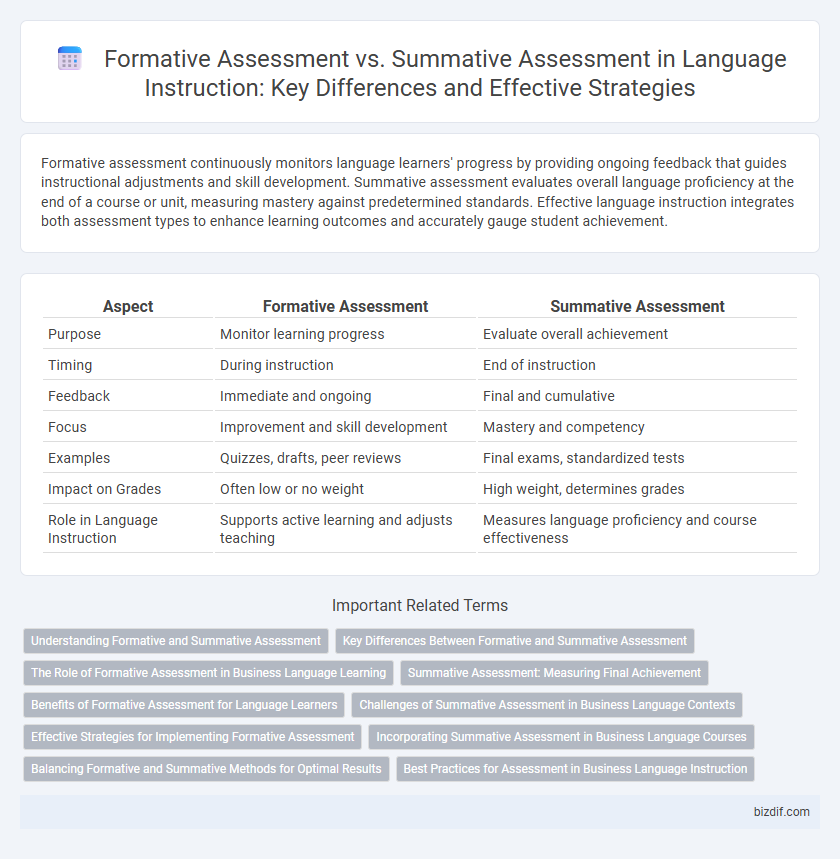Formative assessment continuously monitors language learners' progress by providing ongoing feedback that guides instructional adjustments and skill development. Summative assessment evaluates overall language proficiency at the end of a course or unit, measuring mastery against predetermined standards. Effective language instruction integrates both assessment types to enhance learning outcomes and accurately gauge student achievement.
Table of Comparison
| Aspect | Formative Assessment | Summative Assessment |
|---|---|---|
| Purpose | Monitor learning progress | Evaluate overall achievement |
| Timing | During instruction | End of instruction |
| Feedback | Immediate and ongoing | Final and cumulative |
| Focus | Improvement and skill development | Mastery and competency |
| Examples | Quizzes, drafts, peer reviews | Final exams, standardized tests |
| Impact on Grades | Often low or no weight | High weight, determines grades |
| Role in Language Instruction | Supports active learning and adjusts teaching | Measures language proficiency and course effectiveness |
Understanding Formative and Summative Assessment
Formative assessment involves ongoing evaluations during the learning process to provide immediate feedback and guide instructional adjustments, enhancing student comprehension and skill development. Summative assessment occurs at the end of an instructional period, measuring overall learning outcomes against predefined standards to determine final achievement levels. Understanding the distinction between formative and summative assessments enables educators to balance continuous improvement with comprehensive evaluation, optimizing language instruction effectiveness.
Key Differences Between Formative and Summative Assessment
Formative assessment is an ongoing process that provides immediate feedback aimed at improving student learning through quizzes, observations, and interactive activities, while summative assessment evaluates student comprehension at the end of an instructional period using final exams or standardized tests. Formative assessments focus on identifying learning gaps and adjusting teaching strategies, whereas summative assessments measure overall achievement and assign grades. The key differences include timing, purpose, and impact on instructional decisions, with formative assessments being diagnostic and summative being evaluative.
The Role of Formative Assessment in Business Language Learning
Formative assessment in business language learning plays a crucial role in providing ongoing feedback that helps learners identify strengths and areas for improvement in real-time. It facilitates the development of practical communication skills essential for professional environments by encouraging continuous practice and adjustment. This approach increases learner engagement and retention by aligning instructional strategies with individual progress and business-specific language needs.
Summative Assessment: Measuring Final Achievement
Summative assessment evaluates a learner's overall achievement by measuring knowledge and skills at the end of an instructional period, often through final exams, standardized tests, or end-of-term projects. This type of assessment provides quantifiable data on student performance, informing grades and academic progression decisions. Summative assessments are essential for validating curriculum effectiveness and ensuring benchmarks for language proficiency are met.
Benefits of Formative Assessment for Language Learners
Formative assessment offers language learners continuous feedback that targets specific skills such as vocabulary, grammar, and pronunciation, enabling timely adjustments and personalized learning paths. It fosters active engagement and motivation by highlighting progress and identifying areas needing improvement before final evaluations. This approach enhances language acquisition by promoting deeper understanding through regular practice and reflection within the instructional process.
Challenges of Summative Assessment in Business Language Contexts
Summative assessment in business language contexts often faces challenges such as failing to capture real-time communication skills and practical language use in dynamic workplace scenarios. It tends to emphasize final outcomes over ongoing progress, which can limit the ability to identify and address learners' specific areas for improvement. This approach may also overlook the nuanced language competencies needed for effective negotiation, presentation, and cross-cultural communication in business environments.
Effective Strategies for Implementing Formative Assessment
Formative assessment in language instruction enhances student learning by providing continuous feedback that guides instructional adjustments and student self-regulation. Effective strategies include frequent low-stakes quizzes, interactive activities such as peer reviews, and real-time oral feedback during discussions to identify comprehension gaps. Utilizing digital tools like language learning apps and platforms facilitates timely data collection and personalized support, fostering ongoing language skill development.
Incorporating Summative Assessment in Business Language Courses
Summative assessment in business language courses provides a comprehensive evaluation of learners' proficiency and practical application of language skills in real-world business contexts. By integrating final exams, project presentations, and case study analyses, instructors can measure overall progress and readiness for professional communication challenges. This approach helps ensure that language development aligns with specific business objectives and industry standards.
Balancing Formative and Summative Methods for Optimal Results
Balancing formative and summative assessment methods enhances language instruction by providing ongoing feedback and measuring overall proficiency. Formative assessments, such as quizzes and peer reviews, support skill development and address learning gaps in real-time. Summative assessments, like final exams and standardized tests, evaluate cumulative knowledge, ensuring a comprehensive understanding of language competencies.
Best Practices for Assessment in Business Language Instruction
Formative assessment techniques such as regular quizzes, peer feedback, and real-time language use monitoring enhance learner engagement and proficiency in business language instruction. Summative assessments including final presentations and comprehensive exams effectively measure overall language competence and business communication skills. Integrating authentic business scenarios and customized feedback ensures assessments align with practical language application in professional settings.
Formative Assessment vs Summative Assessment Infographic

 bizdif.com
bizdif.com